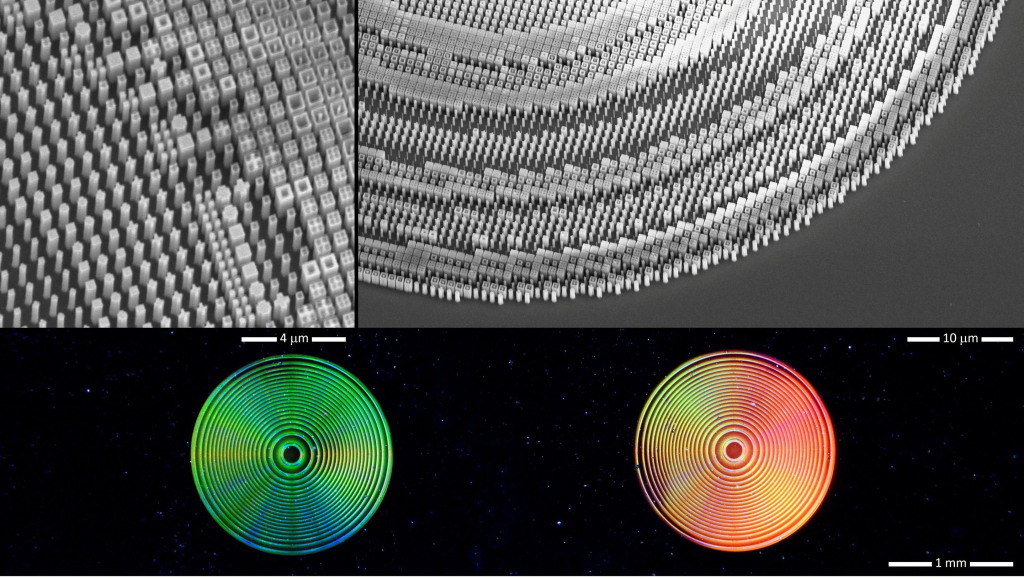
Meta lens technology is revolutionizing the way we perceive and interact with light, paving the way for groundbreaking advancements in various fields. Developed through rigorous research and experimentation, this innovative approach utilizes mini lenses composed of tiny pillars to manipulate light effectively, making them a game-changer in consumer electronics. With prominent figures like Rob Devlin leading the charge, the applications of metasurface technology are rapidly expanding, impacting everything from smartphones to advanced imaging systems. Metalenz, the startup behind this technology, has successfully integrated their light-focusing metasurfaces into popular devices such as the iPad and Samsung Galaxy S23 Ultra, showcasing the real-world potential of polarization technology. As the demand for smaller, more efficient optical components grows, meta lens technology stands at the forefront, promising to disrupt traditional lens manufacturing and redefine the limits of optical innovation.
The emergence of miniaturized lens systems, commonly referred to as meta lenses, has sparked a new wave of innovation across multiple industries. These advanced optical components leverage metasurface applications to create compact solutions that enhance device performance and reduce costs. Pioneered by experts like Rob Devlin, this technology is a testament to the potential of academic research translating into practical consumer products. As businesses seek to incorporate sophisticated optics into their offerings, the unique capabilities of polarization technology are setting a new standard. The integration of these innovative lens systems not only caters to the demand for more advanced electronics but also opens avenues for future developments in imaging and sensing technologies.
The Rise of Mini-Lenses in Consumer Electronics
The evolution of mini-lens technology has been rapid and transformative, paving the way for innovation in consumer electronics. Mini lenses, compact yet powerful, are designed to optimize space within devices like smartphones and tablets. Traditional optics, with their bulky size and weight, have been overshadowed by the emergence of mini lenses, which can achieve the same functionality while taking up significantly less space. Rob Devlin’s journey, from creating over 100 prototypes during his Ph.D. at Harvard to running Metalenz, illustrates this paradigm shift. The demand for mini-lenses has surged as manufacturers seek to enhance the capabilities of their devices without compromising on design or functionality, making this technology an integral part of modern consumer electronics.
As companies like Metalenz push the boundaries of what mini lenses can do, the implications for consumer electronics are profound. Instead of being mere components, these lenses are becoming the backbone of advanced imaging technologies that power features such as 3D sensing and augmented reality. The relentless pursuit for slimmer design without sacrificing performance has led to a new era of devices that are not only more aesthetically pleasing but also equipped with superior technological capabilities. The success of devices utilizing mini lenses, like the Samsung Galaxy S23 Ultra, reflects a significant market trend that is likely to continue as user demands evolve.
Understanding Metasurface Applications
Metasurface applications represent a revolutionary stride in optical design, offering unprecedented control over light at a microscopic level. These surfaces, crafted through innovative techniques in nanofabrication, allow for the manipulation of light in ways that traditional lenses simply cannot match. They are capable of performing complex tasks — from focusing light to filtering and even guiding it — all while being vastly more compact. The emergence of metasurfaces not only enhances the functionality of existing devices but also opens the door to entirely new applications that harness the unique properties of light.
The integration of metasurfaces in consumer electronics is particularly noteworthy in areas such as facial recognition technology and 3D mapping. By utilizing these advanced optical elements, devices can achieve more accurate depth perception and image processing. For instance, the partnership between Metalenz and STMicroelectronics exemplifies how metasurfaces are being utilized in applications requiring precise distance measurements, showcasing their potential for further innovation. As the technology continues to mature, the range of applications for metasurfaces is likely to expand, influencing everything from smartphones to more sophisticated imaging systems.
The Impact of Rob Devlin and Metalenz
Rob Devlin’s leadership at Metalenz marks a significant chapter in the commercialization of cutting-edge optical technologies. Having transitioned the concept of metalenses from research to mass production, Devlin embodies the spirit of entrepreneurial innovation. Under his guidance, Metalenz has produced millions of these mini lenses, challenging traditional optics and significantly altering the landscape of consumer electronics. His efforts have not only highlighted the practical applications of metalenses but have also underscored the importance of collaboration across scientific disciplines in driving technological advancements.
Furthermore, Devlin’s strategic approach to leveraging existing manufacturing processes ensures that Metalenz can meet the burgeoning demand for mini lenses in consumer electronics. As tech giants seek ways to integrate bulkier functionalities into sleeker designs, the contributions of startups like Metalenz become paramount. The feedback loop of continuous improvement and innovation serves to keep Metalenz ahead of competitors, ensuring that they remain at the forefront of optical technology.
Polarization Technology: A Game Changer
Polarization technology offers a groundbreaking shift in how devices perceive and interpret the world around them. By harnessing the unique polarization signatures of objects, Metalenz is developing solutions that enhance security features in devices, such as smartphones. This technology moves beyond traditional imaging, allowing devices to differentiate between genuine and simulated entities effectively. As Rob Devlin noted, the potential for polarization technology extends beyond enhancing security to applications in medical diagnostics and environmental monitoring.
The advent of Polar ID at Metalenz exemplifies how polarization can be harnessed for both cost and size reductions in technology. Traditional polarization cameras can be prohibitively large and expensive, but the innovations at Metalenz promise to democratize access to these advanced capabilities. By enabling affordable and compact devices to utilize polarization, the company is setting the stage for widespread adoption across various consumer electronics, making polarization a viable option for manufacturers aiming to bolster their product offerings.
Future Trends in Optical Technology
As we look towards the future of optical technology, it’s clear that innovations like mini lenses and metasurfaces will redefine what is possible in consumer electronics. The drive towards smaller, more efficient devices will necessitate a further focus on integrating advanced optical technologies. Companies that embrace these trends will likely lead the market, transforming everyday objects into smart, responsive entities through enhanced imaging capabilities and novel functionalities.
Additionally, as consumer expectations evolve, manufacturers will need to invest in research and development to stay ahead of the curve. This means continued exploration of materials science, nanofabrication techniques, and an understanding of how light behaves at sub-wavelength scales. The interplay of academia and industry, as demonstrated by the collaboration between Rob Devlin’s Metalenz and Harvard, will be crucial in fostering innovation and ensuring that new technologies are rapidly brought to market.
Challenges and Innovations in Mini-Lenses
Despite the incredible advancements made in mini-lens technology, there are challenges that innovators like Metalenz must navigate. Scaling production while maintaining quality and ensuring affordability for consumers can be a delicate balance to strike. Additionally, as competition intensifies, there is a pressing need for continual innovation to differentiate products. Manufacturers must be committed to pushing the boundaries of what mini-lenses can do, which may involve extensive research and development processes.
Moreover, educating potential consumers and partners about the benefits and capabilities of mini lenses is vital for their widespread adoption. As the market grows, Metalenz and others in the industry will need to communicate the unique advantages of their products effectively, highlighting how mini lenses improve user experiences in consumer electronics. This communication can elevate the technology from a niche innovation to a standard component in devices we use every day.
The Role of Research in Optical Advancements
Research plays a pivotal role in the continued evolution of optical technologies, particularly in the development of mini lenses and metasurfaces. Academic institutions are often at the forefront of discovery, pushing the boundaries of what is possible through fundamental science and engineering. With researchers like Federico Capasso leading efforts at Harvard, the collaboration between academia and industry has led to breakthroughs that enable the commercial viability of these technologies.
In particular, the exploration of new materials and fabrication techniques has direct implications for the performances of devices in the consumer market. As insights gained through research translate into practical applications, the potential for innovation grows exponentially. This creates a thriving ecosystem where ideas can quickly become reality, ultimately enhancing user experiences and establishing new standards for quality in optical technologies.
Market Influence of Optical Technologies
The market dynamics surrounding optical technologies are shifting rapidly, driven by innovations like those seen in mini lenses and polarization technology. As devices become more interconnected and the demand for high-quality imaging increases, companies are pressured to innovate continuously. The incorporation of advanced optical components is no longer optional but essential for staying competitive in a saturated market, leading to increased investments in research and development.
Tech giants seeking to gain an edge in consumer electronics are actively partnering with cutting-edge startups like Metalenz, fostering a collaborative environment that encourages rapid technological advancement. This trend not only promotes innovation but also accelerates the pace at which new products reach consumers. Understanding the market’s evolving needs will be crucial for companies looking to leverage optical technologies to set themselves apart.
Potential Applications of Advanced Lenses
The versatility of advanced lenses, particularly metalenses, positions them for a wide range of applications beyond typical consumer electronics. Their unique properties make them ideal for use in fields like augmented reality, robotic vision, and autonomous vehicles. As the demand for advanced functionality in these sectors grows, the ability of metalenses to simplify design and improve performance will provide a competitive advantage.
Moreover, the integration of polarization technology into applications such as medical imaging and environmental sensing will further expand the horizons of what advanced lenses can achieve. By enhancing detection capabilities and offering new ways to interrogate data, these technologies have the potential to touch every aspect of life. Metalenz’s ongoing efforts to innovate and adapt their offerings will play a significant role in shaping the future landscape of optical technology.
Frequently Asked Questions
What is meta lens technology and how does it impact consumer electronics?
Meta lens technology, developed by Metalenz, utilizes metasurfaces to manipulate light more efficiently than traditional lenses. This innovation results in smaller, lighter, and cheaper lenses, making it ideal for consumer electronics like smartphones and tablets. These mini-lenses are mass-produced and help integrate advanced features into compact devices.
How do mini lenses created with meta lens technology improve device functionality?
Mini lenses crafted using meta lens technology enhance device functionality by allowing for thinner designs that can include more features without compromising on performance. By replacing traditional bulky lenses, these metasurfaces can improve optical capabilities such as 3D sensing, facial recognition, and augmented reality applications.
What are some applications of metasurface technology beyond consumer electronics?
Beyond consumer electronics, metasurface technology has diverse applications including 3D sensing modules for robotics, polarization technology for skin cancer detection, and air quality monitoring. The versatility of metasurfaces allows them to be utilized in various scientific and industrial settings, revolutionizing how light is manipulated.
Who is Rob Devlin and what is his contribution to meta lens technology?
Rob Devlin is the CEO of Metalenz, a startup that commercializes meta lens technology. As a former graduate student at Harvard, he played a crucial role in developing mini lenses and advancing the production of metasurfaces, which are now widely used in consumer electronics, enhancing their optical and imaging capabilities.
What advancements does Polar ID bring to meta lens technology?
Polar ID significantly advances meta lens technology by utilizing polarization to provide an additional layer of security in smartphones. It reduces the size and cost of cameras compared to traditional polarization systems, enabling more widespread applications while maintaining high-performance functionalities in security and imaging.
How do metasurfaces compare to traditional lenses in terms of manufacturing?
Metasurfaces, enabled by meta lens technology, are easier to manufacture compared to traditional lenses made from glass or plastic. They can be produced in large quantities using semiconductor chip foundries, allowing for mass production that is both cost-effective and scalable, unlike conventional lens manufacturing which can be more complex.
What are the unique features of meta lens technology that set it apart from conventional optics?
Meta lens technology stands out due to its ultra-thin design, mass production capabilities, and the ability to manipulate light using nanoscale structures. It allows for enhanced performance in compact form factors, providing superior optical capabilities without the bulk associated with traditional optics.
What is the role of polarization technology in the development of meta lenses?
Polarization technology is integral to meta lens development, particularly in applications like Polar ID where it enhances security features. By using a polarization metasurface, devices can differentiate between unique polarization signatures, improving the accuracy and safety of imaging technologies.
How did Metalenz start and what is its vision for the future?
Metalenz was founded in 2016 based on research conducted at Harvard University, specifically the innovations in metasurface technology by Federico Capasso’s lab. The company’s vision is to continue leading in the field of optical innovation by enhancing existing products and exploring new applications to disrupt traditional optics and create new market opportunities.
| Key Point | Detail |
|---|---|
| Introduction of Metalenz | Metalenz, founded in 2016, specializes in mini-lenses developed from Capasso’s lab at Harvard. |
| Innovation of Metalenses | Metal lenses utilize tiny pillars on a wafer to focus light, reducing size and manufacturing costs. |
| Mass Production | Metalenz has produced around 100 million light-focusing metasurfaces for consumer electronics. |
| Industry Impact | Metasurfaces disrupt traditional lens manufacturing and are integrated into popular devices like iPads and Samsung smartphones. |
| Research to Product Transition | Transitioned from research prototypes in 2016 to commercial products quickly. |
| Future Developments | Upcoming technology Polar ID will enhance smartphone security and reduce costs and size for devices. |
Summary
Meta lens technology represents a revolutionary advancement in optical engineering that has transformed the ability to manipulate light in consumer electronics. From its inception in a Harvard lab to mass production and real-world applications, this technology signifies not only the efficiency and effectiveness of compact optical solutions but also the potential for future innovations like the Polar ID system. Understanding and utilizing meta lens technology is crucial for staying at the forefront of the ever-evolving landscape of technological advancements.


